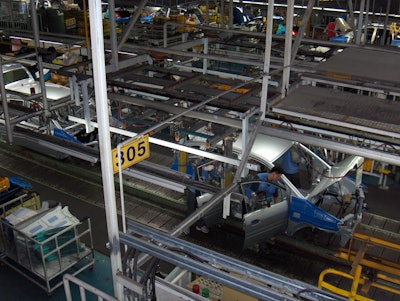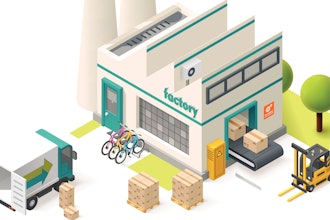
 Manufacturers are always looking to push themselves and their machines harder to boost output and improve productivity. Every dollar earned pushes us higher toward meeting new profitability heights, and there are many steps that can help us grow.
Manufacturers are always looking to push themselves and their machines harder to boost output and improve productivity. Every dollar earned pushes us higher toward meeting new profitability heights, and there are many steps that can help us grow.
Four of my favorite areas to look at for improvements to output are the materials used, the incentives used to drive up numbers, the workers outside of the factory walls, and anyone with something to share.
In the era of lean manufacturing, it’s time to smooth out as much of the operation as possible, while still celebrating the staff. No matter what method you use to increase your output, never forget that the workers who churn out product are a vital piece of production and need to be engaged with at every step.
Improving Raw Material Use
Raw materials typically account for the most expensive, continuous cost, but they can’t be done away with – they’re manufacturing’s lifeblood. Their importance means we’ll often take special care in their acquisition, shipping and processing, and accepting scenarios like price fluctuation that we wouldn’t put up with elsewhere.
The essential way to improve operations via raw material use is to focus on waste and effort being used for procurement through production. Raw materials must move as quickly through processes as possible with as few touch points as possible to maintain integrity and reduce waste.
Unfortunately, there’s no magic bullet that every manufacturer can use to make gains around raw materials. The closest thing is data analytics.
To improve how well you use your raw materials, you’ll need to collect information on the use at every point in your supply chain and production cycle. Track whichever metric is most important for your manufacturing, such as weight and waste production. If steps in your process require a specific transition, you should make note of these special characteristics, such as temperature throughout if one step waits for metal to cool.
As you start upgrading equipment or look to reduce your carbon footprint, monitor the energy used at each step in your processing and see if you can take those steps in a more efficient manner.
Many raw-material bottlenecks can be solved by shifts in production or a reduction in handling as goods transition through your facility.
Incentives for One or All?
Manufacturers can often improve production yield by setting a realistic goal of increased production, and providing incentives if that goal is reached. Incentive plans can give you a boost without an increased cost, but you’ll need to determine what type of plan is right for you.
The initial choice is between individual or team-based incentives.
Individual incentives provide a boost to specific tasks and work well across specialized assembly lines or in spaces where one job can cause a significant delay.
Incentivizing individual performance is often incredibly complicated for manufacturers since little work is done in isolation.
If you identify a bottleneck that an individual can address, you can create a specific plan that may improve the flow of your entire operation. Another benefit for individual incentives is that you may not have to apply them across an entire company or line if the work is significantly isolated.
Team incentives are standard for manufacturers because they focus on improving the overall efficiency of the line. Normally everyone must work together, so tying incentives together does not break this existing bond. Encouraging cooperation can be beneficial if the goals are truly attainable because it reduces the chance of blame.
 The crowd-funding service Kickstarter may be the best place for you to look for incentive ideas because of its “stretch” goal options. Projects looking for funding have a baseline amount they want to achieve, but then set higher goals that provide special rewards for backers if they’re met. These stretch goals aren’t required for the project or for the initial rewards provided to backers.
The crowd-funding service Kickstarter may be the best place for you to look for incentive ideas because of its “stretch” goal options. Projects looking for funding have a baseline amount they want to achieve, but then set higher goals that provide special rewards for backers if they’re met. These stretch goals aren’t required for the project or for the initial rewards provided to backers.
Using a tiered-reach goal may be a great way to motivate your team. Set a production goal that you know is achievable and give out 75% of the total reward you’re willing to provide when it’s met. The remaining 25% can be tied to an additional production goal that’s harder to achieve.
Even if this final goal isn’t met, your employees are being rewarded for their hard work and extra effort. This allows you to acknowledge hard work in a realistic fashion while also pushing employees to stretch until the last minute to get to that larger goal.
Go With the Flow, Everywhere
Every interruption to your production line is a costly affair, and it’s likely you’ve already worked put a variety of thought and effort into ensuring that your line flows smoothly.
Have you done the same with your backend office or corporate HQ?
Information and projects spread through your organization much like goods move through your line. Different teams and individuals provide input, changes and additions to your projects as they move, with constant quality checks happening along the way. Unfortunately, offices are much more prone to distraction and interruption, which can cause your line to seize up unnecessarily.
It’s time we applied our thoughts on logistical models and lean assembly lines to our daily work where email, phone calls, afternoon meetings and small fires seem to be a source of constant interruption.
The practice of applying a lean flow to your office depends on the structure and size of your team. For manufacturers, this will often mean breaking staff into small groups for each new product you’re researching or marketing tactic you plan on trying.
If you’re creating a whitepaper with input from multiple departments, move it through piece-by-piece before passing back with a final review. Limiting the how much projects circle back to the beginning can improve their production. However, like we do with our lines, there should be periodic checks that test and see if something is worth pursuing or needs to be redone.
Like all manufacturing work, send it back to the starting point if something on the line won’t meet your standards or do the job, no matter if it’s in your plant or marketing department.
Asking For Help
The easiest method to increasing manufacturing output can be something you’re overlooking. Unfortunately it happens to all of us at some point. There’s usually a fix that’s staring us in the face, but we’re too busy looking at current operations to see it.
That’s where outside help comes in.
There are a multitude of consultants who specialize in improving production and efficiency, and at times, it’s okay to ask and seek that help.
Don’t forget about your team members, though. You’ve got people who are staring at problems every day and they may have thought up a great fix, but never had the courage or the chance to say anything.
While there may be “stupid” ideas to implement, there are no stupid suggestions to consider or questions to ask. By seeking out employee feedback, you’ll be actively engaging people who have a stake in how well your operations perform. Asking also gets some workers thinking about improvement for the first time, and you never know when a ‘Eureka!’ moment will strike.
Working with machines can often make it feel like the best improvement is simply figuring out which part to replace, but your workforce can give you perspectives that no gear change could ever show.
Philip Odette is the CEO of Global Supply Chain Solutions (GSCS) and passionately pursues enriching the lives of its stakeholders while developing the supply chains of its customers. GSCS has optimized hundreds of high-tech companies’ supply chains, enabling them to become the leaders in their respective market space. Philip serves on the board of several other entities, striving in each instance to leave every person, company, and cause with dramatically improved circumstances.























